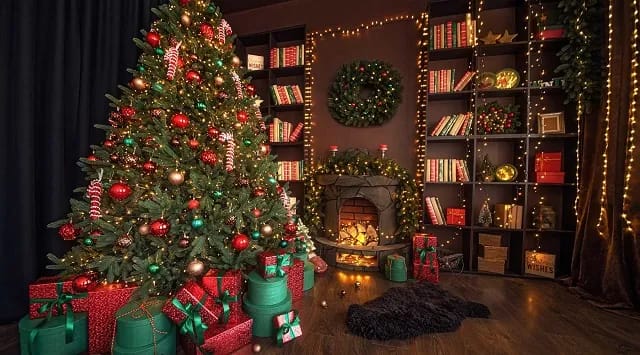When the first snowflakes begin to fall and the air turns crisp, there’s something magical about the warm glow of Christmas lights. Streets shimmer with color, trees sparkle, and homes radiate a festive warmth that instantly lifts the spirit. But have you ever stopped to wonder why we decorate our homes and trees with lights every Christmas?
This tradition is more than just a beautiful spectacle — it’s a symbol of hope, faith, and celebration that has evolved over centuries. From candles on pine trees to dazzling LED displays, the story of Christmas lights is a fascinating journey through history, culture, and human creativity.
Let’s dive deep into the glowing history and meaning behind one of the most beloved holiday traditions in the world — Christmas lights.
Read More:
- What Are Christmas Lights Called?
- Christmas Lights Outdoor: Transform Your Home into a Winter Wonderland
- Christmas Lights In Different Cultures
The Origins: Light as a Symbol of Hope and Faith
Long before electricity illuminated our Christmas trees, people were drawn to the symbolic power of light. In many cultures, light represents life, warmth, and hope — especially during the darkest time of the year.
Winter in the Northern Hemisphere brings long nights and short days. Ancient civilizations often celebrated festivals of light to mark the winter solstice, the moment when daylight begins to return. For example:
- The Romans celebrated Saturnalia, a festival honoring Saturn, god of agriculture. Homes were adorned with candles and evergreen wreaths to celebrate renewal.
- The Celts burned Yule logs as part of their winter solstice rituals, symbolizing the rebirth of the sun.
- Jewish people celebrate Hanukkah, the Festival of Lights, commemorating the miracle of the temple oil that burned for eight days.
These early customs show that long before the birth of Christ, light was a universal symbol of endurance and faith — a way to conquer darkness and bring comfort to cold winter nights.
The Christian Connection: The Light of Christ
As Christianity spread across Europe, it absorbed many pagan symbols and reinterpreted them through Christian faith. Light took on a deeply spiritual meaning.
In the Bible, Jesus is often referred to as “the Light of the World.” For early Christians, light symbolized the presence of God, purity, and guidance through darkness. During the Christmas season — celebrating the birth of Christ — light naturally became an essential theme.
By the 16th century, Germans began bringing evergreen trees indoors during Christmas. These trees symbolized everlasting life. To represent Christ’s light, they placed candles on the branches. It was a beautiful but risky practice — one that required careful supervision to prevent fires.
Yet despite the danger, the custom spread across Europe, as people were drawn to the profound beauty of a glowing tree in the dark heart of winter.
The Birth of the Christmas Tree Lights
The tradition of decorating Christmas trees with candles eventually became a hallmark of European Christmas celebrations. However, the leap from candles to electric lights is what truly revolutionized the holiday.
This transformation began in the late 19th century, and it’s tied closely to one of history’s greatest inventors: Thomas Edison.
Edison’s Spark of Inspiration
In 1880, just a year after inventing the light bulb, Edison had a bright idea — literally. He hung a string of electric lights outside his laboratory in Menlo Park, New Jersey, during the holiday season. It was both a marketing stunt and a celebration of innovation. People were amazed by the glowing bulbs that illuminated the night, offering a safer and more brilliant alternative to candles.
Edward H. Johnson and the First Christmas Tree Lights
Two years later, Edison’s colleague and friend, Edward H. Johnson, took the idea even further. Johnson hand-wired 80 red, white, and blue bulbs and strung them around his Christmas tree in his New York home. The tree sat on a rotating platform, dazzling guests and the media.
The press dubbed it “Johnson’s Christmas Tree,” and though it was an expensive novelty at the time, it marked the birth of modern Christmas tree lighting.
From Luxury to Tradition: The Rise of Electric Christmas Lights
At first, electric lights were a luxury few could afford. In the early 1900s, a single string of electric lights could cost the equivalent of hundreds of dollars today. Electricians had to be hired to wire and install them, making them a status symbol for the wealthy.
However, as electricity became more widespread and affordable, Christmas lights became accessible to ordinary families. Companies like General Electric and NOMA (National Outfit Manufacturer’s Association) began mass-producing light strings in the 1920s and 1930s.
Soon, homes across America twinkled with electric lights each December. What began as an exclusive experiment became a joyful tradition shared by millions.
Post-War America: The Explosion of Christmas Light Culture
The end of World War II brought economic prosperity and a renewed desire for celebration and community. Christmas lights became a way for families to express joy, hope, and unity.
By the 1950s, entire neighborhoods began to decorate their homes, turning streets into glowing wonderlands. Department stores installed elaborate window displays, cities lit up public trees, and holiday parades sparkled with color.
The practice spread globally, with cities from London to Tokyo embracing light displays as symbols of festivity and goodwill.
This post-war period solidified Christmas lights not just as a decoration — but as a cultural expression of happiness and peace.
The Deeper Meaning: Why We Still Light Up Today
Beyond the aesthetics, Christmas lights carry profound symbolism that still resonates in modern times.
1. Hope in Darkness
At its heart, the tradition reflects our need for hope during the darkest days of winter. Each light is a reminder that even in tough times, brightness can return.
2. Faith and Renewal
For Christians, lights symbolize the divine light of Christ. For others, they represent renewal — the promise of a new year and brighter days ahead.
3. Togetherness and Celebration
Stringing up lights brings people together. Families decorate homes, friends visit light displays, and communities unite to share joy.
4. Nostalgia and Comfort
The glow of Christmas lights evokes memories — childhood wonder, family gatherings, and the magic of Christmas mornings. It’s a comforting ritual that connects generations.
Christmas Lights Around the World
Today, Christmas lights have transcended religion and geography, becoming a universal symbol of festivity and goodwill. Let’s take a quick trip around the world to see how different cultures celebrate with light.
1. The United States
Americans take Christmas lighting to a spectacular level. From modest home displays to professional light shows synced to music, neighborhoods compete to outshine each other. Cities like New York’s Rockefeller Center and Chicago’s Magnificent Mile are global icons of Christmas illumination.
2. The United Kingdom
In London, Oxford Street and Regent Street glow with stunning light installations. Families gather for the annual “switch-on” ceremonies, often featuring celebrities and carolers.
3. Germany
As the birthplace of the Christmas tree, Germany’s markets are famous for their cozy lights, candles, and lanterns. Town squares twinkle with charm, creating a warm festive atmosphere.
4. Japan
While Christmas isn’t traditionally religious in Japan, illumination festivals have become hugely popular. Cities like Tokyo and Osaka host dazzling light shows that attract millions of visitors.
5. The Philippines
Known for celebrating the longest Christmas season in the world, the Philippines features the parol — a beautiful star-shaped lantern symbolizing the Star of Bethlehem. These lanterns light up streets and homes from September through January.
6. Australia
In the Southern Hemisphere, Christmas arrives in summer. Yet, Australians still embrace the glow — with outdoor lights, beachside decorations, and massive community displays that brighten warm December nights.
The Evolution of Christmas Lights Technology
Christmas lights have evolved dramatically since the days of Edison and Johnson.
1. The Era of Incandescent Bulbs
For much of the 20th century, glass incandescent bulbs dominated the market. They were bright but fragile and consumed a lot of energy.
2. Mini Lights and Plastic Innovation
In the 1970s and 1980s, manufacturers developed smaller, more affordable plastic bulbs. Mini lights made decorating easier and safer, helping the tradition spread even further.
3. The LED Revolution
Today, LED lights have transformed the Christmas lighting scene. They’re energy-efficient, long-lasting, and available in every color imaginable. They also enable spectacular light shows, synchronized displays, and programmable effects.
4. Smart Lights and Sustainability
In recent years, smart technology has brought customization to a new level — app-controlled lights that change colors, flash to music, and even respond to voice commands. Meanwhile, many households are choosing eco-friendly options like solar-powered or recycled-material lights to reduce environmental impact.
The Psychology of Christmas Lights
It’s not just tradition — there’s actual psychology behind why Christmas lights make us feel happy.
- Light triggers dopamine, the “feel-good” hormone, boosting mood and reducing stress.
- Colorful lights stimulate the senses and create a sense of wonder.
- Nostalgia plays a powerful role — lights remind us of joyful childhood moments.
In essence, Christmas lights don’t just decorate our surroundings; they illuminate our emotions. They reconnect us to joy, warmth, and shared humanity.
The Modern Spirit: Community and Creativity
Today, Christmas lights have become a global form of creative expression.
- Festivals of lights like Lumiere London or Dyker Heights in New York draw millions of visitors.
- Charity light shows raise funds for good causes, turning decoration into generosity.
- Social media challenges inspire people to share their light displays with the world, spreading cheer across borders.
In a world that often feels divided, the simple act of lighting up our homes and cities reminds us of what unites us — joy, beauty, and togetherness.
Conclusion: More Than Just Lights — A Symbol of Human Spirit
So, why are Christmas lights a tradition?
Because they represent everything we cherish during the holiday season — hope, faith, love, and the triumph of light over darkness.
From ancient solstice fires to Edison’s electric bulbs, from candlelit trees to LED spectacles, the tradition of Christmas lights has evolved — yet its message remains timeless.
Every twinkling bulb tells a story. A story of humanity’s enduring optimism. Of people across centuries finding beauty in the darkest nights. Of families gathering under glowing trees, hearts warmed by the same radiant glow that has guided generations.
When you plug in your Christmas lights this year, remember: you’re not just decorating your home — you’re continuing a centuries-old tradition that celebrates the light within us all.
And that’s the real magic of Christmas.


